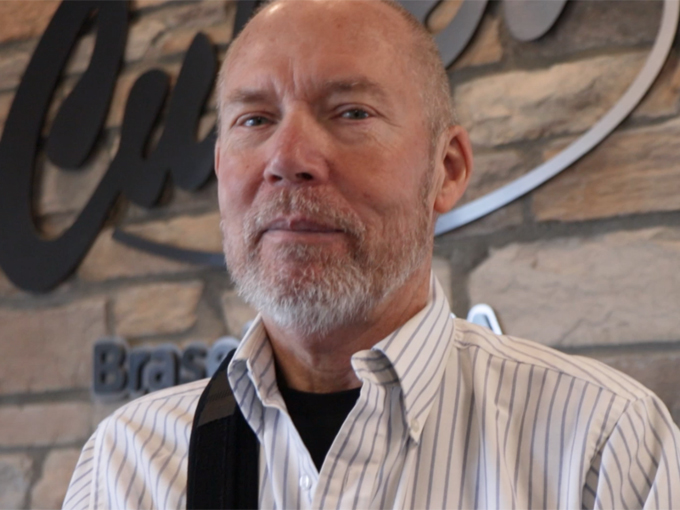
by David Bass | Mar 11, 2019
We know that people do better in life when they experience the benefits of meaningful work and healthy relationships. But we also know that so many cultural forces are stacked against success in these two areas. One of the biggest is the American welfare system, which keeps people trapped in cycles of dependence while reducing incentives to climb the economic ladder or form stable relationships.
That’s why the Georgia Center for Opportunity has been on the vanguard of work-focused welfare reform that gives a hand-up to struggling people while preserving the social safety net for those who truly need it. The great news is that we’re seeing growing momentum—both at the state and national level—to make these reforms a reality.
Georgia lawmakers are poised to consider legislation in the General Assembly to take significant steps on welfare reform—what we call the “right to strive”—while nationally we are seeking waivers to expedite the reform package at the state level. In recent months, we’ve presented our welfare research to Georgia’s Rural Economic Development Committee, created by former Gov. Nathan Deal and the legislature to help rural Georgia communities become more competitive economically. The committee was already well aware of the damage caused by welfare cliffs in the lives of individuals and businesses, so they were very welcoming of our input. We’ve also met with policymakers in Washington, D.C., on our welfare reform proposals.
The changes can’t come soon enough. Although the Georgia economy is booming with a historic 3.6% unemployment rate, these trendlines obscure a hidden workforce crisis: Millions of Americans aren’t counted in the official unemployment rate because they’ve simply given up looking for work. A crucial step in the right direction for these non-working individuals is to create a welfare system that helps—rather than hinders—their connection to meaningful work.
The most important changes in our proposal are to reduce welfare “cliffs,” a scenario where benefit drop-offs unfairly punish workers for earning more and moving up the economic ladder. Secondly, our proposals eliminate the marriage penalty that encourages single parenthood.
A big step to accomplish this is by consolidating the major 15 welfare programs hosted by federal, state, and local agencies into five coordinated programs, headed by a sole lead agency. In the end, our reforms stabilize the safety net for those who truly need it, adopt a “work first” approach for those who are able, and create incentives to form marriages and households.
We’re optimistic that we will soon see work- and family-focused “right-to-strive” reforms in Georgia. Interested in learning more? Don’t miss our three-part series of reports on welfare reform: Part 1, part 2, and part 3.

by David Bass | Jan 29, 2019
It may surprise you to learn that data from the U.S. Census data show that just 2.4 percent of those who work full-time year-round live in poverty. In contrast, 14 percent of those who did work—but not full-time, and not year-round—were in poverty, and fully 32 percent of those who did not work at all lived in poverty.
Surprisingly, these numbers are nothing new. Economist Lawrence Mead noted in his book From Prophesy to Charity: How to Help the Poor that the poverty rate in 2009 for those who worked at least a 35-hour work week for 50 weeks of the year was just 3 percent. Mead summarizes: “The lion’s share of adult poverty is due, at least in the first instance, to low working levels.”
Clearly, the key to escaping poverty isn’t merely raising wages, as important as that might be. It’s full-time (or close to full-time) work. And one of the key ways to help our neighbors escape poverty is straightforward and simple: help them get job training, land a stable job, and advance into higher paying positions over time.
To this end, we are proud of the impressive results flowing out of our workforce initiative, Hiring Well, Doing Good (HWDG). By breaking down the key barriers to full-time employment—lack of education and job skills—HWDG connects local employers and community leaders with job seekers to provide valuable training that leads to stable, good paying jobs that lift people out of poverty and break the cycle of generational poverty and government dependency.
We believe that the best solutions to problems are at the local level. And we believe that the reason HWDG is the most effective job placement program in Georgia is because it moves beyond political grandstanding and offers a real solution to the core problem—the need for sustainable jobs.
In our booming economy, there’s little reason for those who want to work to remain mired in poverty. Job initiatives like HWDG give motivated individuals a second chance and much-needed on-the-job training to get a solid job that leads to a life of dignity and thriving.
by Georgia Center for Opportunity | Aug 20, 2015

By now, almost everyone who isn’t a Democratic United States Senator has seen at least one of the five macabre videotapes released by the Center for Medical Progress, a pro-life investigative group. The videos are ubiquitous in social media, so I won’t provide links to them here.
In a recent post, AJC columnist Jay Bookman has provided a nice example of the arguments offered by those who continue to defend Planned Parenthood in the face of these—to say the least—embarrassing revelations. Here are his five points, together with my responses.
1. Nothing in the tapes provides evidence of illegal, let alone criminal, behavior. Planned Parenthood is allowed by law to recover its costs in collecting, preserving and transporting that tissue, and there is no evidence it violated that law. Tellingly, and despite the melodramatic complaints of conservatives, the videos have so far resulted in no criminal investigation or prosecution by state or federal authorities. Yelling and the beating of chests doesn’t alter that basic fact. Fabricated outrage doesn’t change that. Simply put, in legal terms there is no “there” there.
Not so fast, Mr. Bookman. The Planned Parenthood representatives are indeed cagey and circumspect and there is, to be sure, no straightforward smoking gun, but like all bureaucrats, they seem to know that there are expenses and then there are expenses. It may take a lot of trouble to untangle what’s a genuine “cost” and what amounts to a profit over and above costs. That the Department of Justice or a federal prosecutor hasn’t yet commenced an investigation doesn’t mean that the DOJ or a D.A. won’t, though given the track record of this Administration with respect to abortion, I’m not holding my breath. A real federal investigation may have to await a new Administration, or a Congressional investigation that forces the current Attorney General’s hand. So there is nothing at all “telling” about the lack of federal action so far. And if I’m not mistaken, at least twelve states have commenced investigations.
2. The law making such research legal was passed in 1993, and among those voting in favor of that bill was one Mitch McConnell, the same man who now claims that videos documenting what he voted to make legal “absolutely shock the conscience.” Other current GOP senators who backed that ’93 law were Richard Shelby, John McCain, Dan Coats, Chuck Grassley, Thad Cochran and Orrin Hatch, many of whom are now backing a shutdown.
Even if the research is authorized by law, it’s one thing to consider that research in the abstract, another altogether to confront graphically what it means and requires (the dissection of a recognizably human body). Perhaps the law needs to be changed. And even if we decide not to change the law that permits the research, there’s no reason why we have to fund either it or the organization that provides the human organs on which the researchers work.
3. Those receiving the fetal tissue are not ghouls of some sort, and the tissue is not being put to inappropriate or disrespectful use. To the contrary, the tissue is crucial to research into treatments to extend and improve human life, research that would be impossible to conduct without that material. As the New York Times reports, “the National Institutes of Health spent $76 million on research using fetal tissue in 2014 with grants to more than 50 universities, including Columbia, Harvard, the Massachusetts Institute of Technology, Stanford, Yale and the University of California in Berkeley, Irvine, Los Angeles, San Diego and San Francisco.”
While we aren’t necessarily talking about Dr. Josef Mengele here, why must we assume a congruence between the demands of science and “democratic” morality? A careful reading of Francis Bacon’s New Atlantis—the great work on science and politics written by the greatest and most perspicuous thinker on that subject—makes it clear enough for anyone who has eyes to see that there’s a pretty significant disconnect between science and ordinary morality. Curiosity and the ambition to master nature can take one pretty far from what’s decent and respectful. The more powerful science is, the greater mastery of nature it promises us, the more attention we must pay to it and the less we should avert our eyes from its practices. There may be benefits—which, by the way, are at the moment for the most part simply speculative—that aren’t worth the cost.
4. All tissue used in that research is donated by clinic patients, who receive no compensation for doing so. Their sole motive is to help fellow human beings. If we ban the use of such material in research, we accomplish absolutely nothing except to halt that potentially life-saving research. So which is the true “pro-life” position?
As C.S. Lewis argues in The Abolition of Man, there’s a moral cost in treating human beings as meat, or of denying the humanity of a being that is recognizably human. In so doing, we run the palpable risk of dehumanizing ourselves, of numbing our moral sense. Indeed, Lewis’s work ought to be absolutely required reading for anyone who wishes to comment intelligently on these issues.
5. None of the $500 million in federal funding going to Planned Parenthood is used to finance abortions. It is used instead to give low-income women access to contraceptives, maternity care, breast-cancer and ovarian-cancer screenings, and vaccinations against sexually transmitted diseases. If we strip Planned Parenthood of funding for such programs as punishment for the “crime” of following the law and providing tissue for medical research, no other organization has the infrastructure, personnel and training to provide those health-care services. In effect, those women and their children would be the innocent victims of a successful effort to defund Planned Parenthood.
While there may not be a single national organization capable of picking up the slack of PPFA’s arguably overstated non-abortion business, the federal funding that it receives can be put to precisely the same use by a myriad of community health centers and nonprofits in the health, not the abortion, business all over the country. Indeed, the proposed Senate bill preserves every penny of women’s health funding, mandating simply that it go to health clinics, not abortion clinics.
I’ve mentioned two pieces of what I regard as required background reading. Let me close with a third, Dr. Leon Kass’ classic, “The Wisdom of Repugnance”:
Revulsion is not an argument; and some of yesterday’s repugnances are today calmly accepted-though, one must add, not always for the better. In crucial cases, however, repugnance is the emotional expression of deep wisdom, beyond reason’s power fully to articulate it. Can anyone really give an argument fully adequate to the horror which is father-daughter incest (even with consent), or having sex with animals, or mutilating a corpse, or eating human flesh, or even just (just!) raping or murdering another human being? Would anybody’s failure to give full rational justification for his or her revulsion at these practices make that revulsion ethically suspect? Not at all. On the contrary, we are suspicious of those who think that they can rationalize away our horror, say, by trying to explain the enormity of incest with arguments only about the genetic risks of inbreeding.







